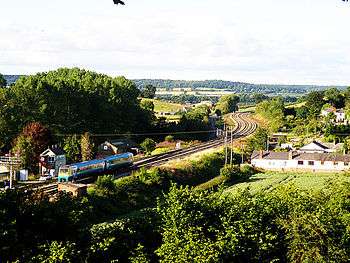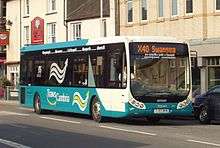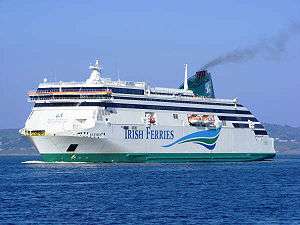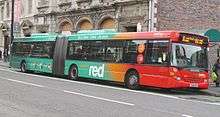Transport in Wales
Transport in Wales is heavily influenced by the country's geography. Wales is predominantly hilly or mountainous, and the main settlements lie on the coasts of north and south Wales, while mid Wales and west Wales are lightly populated. The main transport corridors are east-west routes, many continuing eastwards into England.[1]
Railways
Wales' railway network developed in conjunction with that of the rest of the United Kingdom during the nineteenth century. The North Wales Coast Line and South Wales Main Line sought to profit from traffic between London and Ireland. Numerous railways were built to export coal and iron from South Wales and slate from North Wales. In the latter half of the nineteenth century, tourism was booming and railways served resorts such as Llandudno, Barry Island and locations along the Cambrian Coast Line.
The network was rationalised during the twentieth century (particularly by the Beeching cuts[2]), with mainly east-west routes retained. As a result, the rail network within Wales is no longer contiguous. Devolution led to the formation of a single franchise for Wales in 2003. The Wales & Borders franchise, which includes some railway lines in England for completeness, is currently operated by Transport for Wales. As rail usage has grown during the past decades, several freight lines have seen rail services reintroduced, including the Cardiff City Line, the Vale of Glamorgan Line, and the Ebbw Valley Railway. As of 2008, there are 923 miles (1,485 km) of mainline railways in Wales.[3]
Transport for Wales operate all mainline services wholly within Wales. These range from rural lines such as the Welsh Marches Line to the Cardiff commuter lines, and long distance routes between North and South Wales, via Chester, Wrexham General and Shrewsbury. They also operate services from Wales to Manchester, Crewe, Birmingham and Gloucester. Services to London are operated by Greater Western Railway (from South Wales) and Avanti West Coast (from North Wales). Great Western Railway also operate services from Cardiff to Portsmouth via Bristol, Bath and Southampton, and CrossCountry operate services from Cardiff to Nottingham.
The bulk of rail transport in Wales today is concentrated in the south, with Cardiff Central, Cardiff Queen Street, Newport, Swansea and Cardiff Bay being the busiest stations.[4] Most passengers travel on east-west routes.[1] In 2018-2019, there were 33.5 million rail passenger journeys which either started or ended in Wales, including 24.0 million journeys within Wales. Cardiff was the destination for almost 44 per cent of these journeys.[5] In the north, the bulk of rail travel is concentrated around Wrexham General, Wrexham Central and the Llandudno Junction to Chester section. The South Wales Main Line is being electrified as far as Cardiff Central.[6] Owing to the closure of the line between Swansea and Aberystwyth, and the absence of other north-south routes, it is very problematic to travel from Swansea to Caernarfon by rail.
Urban rail
The only form of commuter rail system in Wales is the Valley Lines network serving Cardiff and the South Wales valleys, serving 20 stations in Cardiff and 61 stations in the surrounding area. Train frequency at the core of the network is up to every 5 minutes.[7]

Tram
The only surviving tram service within Wales is the Great Orme Tramway, a cable-hauled tramway in Llandudno which survives as a tourist attraction.
Cardiff, Swansea and Newport had extensive tram systems until the mid-20th century. Plans were mooted in the late 1990s for a modern tram system to serve Cardiff's urban areas, but these were shelved due to the costs of building and maintaining such a system.[8][9]
The world's first passenger tram service was the Mumbles Railway in Swansea, initially horse-drawn but later operated by steam and electric trams.[10]
The Llandudno and Colwyn Bay tramway, demolished in 1956, has a preservation society which has restored some original carriages.[11]
Heritage railways
Wales has a large number of heritage railways. Some of these were former industrial narrow gauge railways, such as the Corris Railway. Others were formed from portions disused standard gauge railways, either kept as standard gauge (e.g. Barry Tourist Railway) or converted to narrow gauge (e.g. Brecon Mountain Railway). Some of the narrow gauge heritage railways are marketed as the Great Little Trains of Wales[12]
Notable heritage railways include:
- The Talyllyn Railway, the first railway in the world to be saved by a preservation society
- The Snowdon Mountain Railway, the only rack and pinion railway in the United Kingdom
- The Ffestiniog Railway, the oldest surviving railway company in the world
- The Welsh Highland Railway, linking the Ffestiniog Railway at Porthmadog to Caernarfon
- The Gwili Railway, the first standard gauge preserved railway to operate in Wales
- The Vale of Rheidol Railway, the last steam railway owned by British Rail until 1989
Road
The trunk road network carries around one third of road traffic in Wales.[1] Around 80 per cent of traffic on Welsh roads is cars, taxis, and minibuses, mainly on east-west routes in north and south Wales.[1]
South Wales
Wales has 83 miles (133 kilometres) of motorway, all of which are in the south. The major artery is the M4, which enters Wales via the Second Severn Crossing and terminates at Pont Abraham in Carmarthenshire. The M4 in South Wales has 27 junctions and is an important route between the main urban areas in the region. It links Llanelli, Swansea, Neath, Port Talbot, Bridgend, Cardiff and Newport directly to London and the rest of southern England, and indirectly to the Midlands via the A449, A40 and M50.
Following construction of the new bridge, the original Severn Bridge—which crosses the river further upstream at Chepstow—was re-numbered the M48 motorway. Tolls were once collected upon entering Wales using either of the two bridges; these were abolished on 19 December 2018.[13] The A48(M) is a small spur from the M4, from west Newport to east Cardiff.
The second major road is the A470 dual carriageway that connects Cardiff with the South Wales Valleys towns. It suffers from severe congestion especially during peak hours due to significant in-commuting to the Cardiff area.
The A465 Heads of the Valleys road, currently being upgraded to dual carriageway, provides a link between the M4 near Neath across the Heads of the Valleys to Abergavenny, Monmouth and England's West Midlands via the A40 and M50.
North Wales
One of the main arteries for North Wales is the A494, running from Queensferry (near the English border) to Dolgellau. The road begins from the M56 motorway, connecting North Wales with Chester and Manchester Airport, both in England. The more important A55 runs from Holyhead (for ferry connections to Ireland), Conwy, Llandudno Junction and Rhyl to a junction with the M53 motorway near Chester.
One of the oldest roads, the A5 runs from the port of Holyhead south east to Bangor then down through Snowdonia to Betws-y-Coed, Corwen, Llangollen and over the English border south of Chirk. This route has served as the main passage for London-Dublin traffic for many years although its usage has been superseded by the A55 coast road. It is now more famed as a scenic route, and notorious for many Bank Holiday traffic jams.
North–south
Two routes serve as the main north-south links. The A483 begins near Swansea and takes a north-easterly route to Ammanford, Llandeilo, Llandovery, Llanwrtyd Wells, Builth Wells, Llandrindod Wells, Newtown, Welshpool, Oswestry and Wrexham, finally ending at Chester.
The A470 begins in Cardiff Bay and passes through Cardiff, north-to-north-westerly, on to Pontypridd, Abercynon, Merthyr Tydfil, Brecon, Builth Wells, Rhayader, Llangurig, Llanidloes, Llandinam, Commins Coch, Mallwyd, Trawsfynydd, Blaenau Ffestiniog, Dolwyddelan and Betws-y-Coed, terminating at Llandudno. It is a dual carriageway between Cardiff and Merthyr (where it meets the Heads of the Valleys Road, the A465), and the section of this route into Cardiff is heavily used.
Bus and coach network

Bus services are predominantly provided by the council owned Cardiff Bus and Newport Bus in the respective cities. Private sector operators in Wales include:
- Stagecoach South Wales, which provides services on a number of routes centred on Cardiff and the South Wales Valleys,[14] and a low-cost coach service from Cardiff to London as part of its Megabus brand
- First Cymru, which offers services centred on Bridgend, Neath Port Talbot, Swansea, Llanelli, Carmarthen, Haverfordwest and South Pembrokeshire,[15] also providing a key link from Bridgend/Swansea to Cardiff[16]
- Arriva Buses Wales, which provides services through North Wales
- NAT Group, which provides services between East and West Cardiff, and from Central Cardiff to Cardiff Airport, Pontypridd, Barry and Bridgend
In North Wales, National Express offers services from major towns to Liverpool, Manchester, Birmingham, London, Newcastle, Leeds and Bradford.
In South Wales, National Express provides direct services from major towns and cities to Bristol, Gatwick Airport, Heathrow Airport and London Victoria. Services also operate from Cardiff and Newport to Birmingham, Nottingham, Bradford, Sheffield and Hull. Megabus operates services from Cardiff to Bristol, London, Birmingham, Manchester, Leeds and Newcastle.
TrawsCymru is sponsored by the Welsh Government and offers intra-Wales routes, which are:
- Bangor to Aberystwyth via Porthmadog, Dolgellau and Machynlleth;
- Aberystwyth to Cardiff via Aberaeron, Lampeter Carmarthen and Swansea;
- Aberystwyth to Cardigan via Aberaeron;
- Wrexham to Barmouth via Llangollen, Bala and Dolgellau;
- Aberystwyth to Cardigan via New Quay; and
- Brecon to Newtown via Builth Wells and Llandrindod Wells.
Traffic pollution
A number of places in Wales suffer from air pollution.[17]
Airports
Wales has two airports offering scheduled services, Cardiff and Anglesey, with the latter offering only domestic services to Cardiff.
In South Wales the air travel market is estimated to be in the region of 3.5 million passengers, half of whom are served by Cardiff Airport while the remainder travels mainly to Heathrow, Bristol and Gatwick.[1] Over three-quarters of passengers passing through Cardiff Airport are from international flights, and the remainder are domestic passengers mainly travelling between Cardiff and Belfast, Edinburgh, Newcastle, Glasgow or Jersey. The North Wales air passenger market is small and Manchester, Liverpool and Birmingham airports provide the main access.[1]
An air service with a flight time of around one hour between Cardiff Airport and Anglesey Airport started in May 2007, with two return flights a day, and attracted 40,000 passengers over the first 2½ years. It was originally run by Highland Airways but, after that company's closure, was taken over on a temporary basis by Isle of Man-based company Manx2 (now Citywing) in 2010.[18] The service is now operated by Eastern Airways.
Cardiff Airport is the sole airport in Wales for air freight, and is ranked 19th in the UK in terms of freight movement.[1] However, Airbus flies out some of the aircraft wings produced in its Broughton plant.[1]
Cycling
Commuting and Active Travel
According to the National Survey for Wales 2017-18, almost 2% of the Welsh population cycled daily for active travel purposes. In total, 6% of the population actively travelled by bicycle at least once a week. Welsh Government data suggests that cycling in Wales is male-dominated; 12% of men said they cycle at least once per month for active travel purposes in 2017, compared to only 6% of women.[19]
In Wales, the Active Travel (Wales) Act was passed in 2013 which requires ministers and Welsh local authorities to 'map' active travel routes and networks across the country. It also requires Welsh Ministers to "report on active transport in Wales".[20]
In 2018, Cardiff City Council announced plans to develop a Cycle Superhighway network, similar to the network which exists in London. The project has since been rebranded, and five new Cycleways have been proposed in the city. The scheme is due to be completed over a fifteen-year period and is aimed at promoting active travel by bicycle in the city. The first five routes are due to open at the end of the first phase of the project in 2021.[21][22]
Despite Cardiff's Cycleways scheme, Flintshire is Wales' top local authority for active travel by bicycle; in the National Survey for Wales 2017-18, almost 18% of respondents in Flintshire said that they travel at least once per month by bicycle, compared to just over 16% of respondents in Cardiff. Fewer than 4% of the respondents in Carmarthenshire, Newport, Denbighshire and Blaenau Gwent said that they actively travel by bicycle at least once per month.[19]
Leisure
Sustrans maintains several routes in Wales which form part of the National Cycle Network.[23]
Ports
Milford Haven is the fourth-largest port in the UK in terms of tonnage, and the busiest for oil products.[1] Newport is the busiest UK port for iron and steel, and Port Talbot is the third-busiest for ores.[1] In 2005, the freight tonnage share of Welsh ports was:[1]
Ferries

Welsh ports also provide passenger and freight ferry services. In 2005, 3.2 million sea passengers travelled to and from Ireland. Holyhead, the third largest passenger ferry port in the UK, handled over 2.3 million passengers; Fishguard and Milford Haven (Pembroke Dock) handled over 800,000 passengers a year.[1]
The Cardiff Waterbus runs along the River Taff in Cardiff, connecting the city centre with Cardiff Bay and Penarth.
SailRail
Transport for Wales, Iarnród Éireann, as well as Irish Ferries and Stena Line promotes SailRail[24][25]
From South Wales using West Wales Lines to Fishguard Harbour and on Stena Line to Rosslare Europort service which links with the Iarnród Éireann trains to Dublin Connolly on the Dublin–Rosslare railway line. Whilst from North Wales the North Wales Coast Main Line connects Holyhead with a choice of ferries, either Stena Line or Irish Ferries to Dublin Port, for connecting buses to Dublin Connolly railway station.
References
- http://new.wales.gov.uk/deet/publications/transport/wts/wtstrategy/wtsfe.pdf?lang=en%5B%5D One Wales: Connecting the Nation, The Wales Transport Strategy, Welsh Assembly Government, April 2008
- Rowland, Paul (4 January 2018). "The permanent damage Lord Beeching did to Wales and its rail network". Wales Online. Retrieved 4 January 2018.
- According to the "Wales Route Utilisation Strategy – Draft for Consultation" published by Network Rail in 2008, there are 678 miles (1091 km) of railways in Wales, not counting the "heritage" lines.
- Station Usage. Office of Rail Regulation.
- "Rail transport: April 2018 to March 2019". GOV.WALES. Retrieved 3 May 2020.
- http://www.rail.co.uk/rail-news/2014/welsh-electrification/
- http://www.arrivatrainswales.co.uk/WorkArea/showcontent.aspx?id=5138
- http://news.bbc.co.uk/1/hi/wales/1765120.stm BBC News article on ULTra plans for Cardiff Sourced 22 February 2008
- https://www.theguardian.com/business/2002/jan/16/transportintheuk Guardian article Sourced 22 February 2008
- Early Days of Mumbles Railway
- http://swissitalianpaddlesteamers.com/lcbtramsoc/home.html The Llandudno and Colwyn Bay Tramway Society
- http://www.greatlittletrainsofwales.co.uk/
- https://www.severnbridge.co.uk/Home.aspx?.Parent=contact6&FileName=toll-removal-road-works65
- Stagecoach South Wales Bus Routes Map Archived 6 March 2009 at the Wayback Machine
- FirstGroup UK Bus South & West Wales About Us
- FirstGroup UK Bus South & West Wales
- "House price fears growing air pollution". Wales News. Retrieved 7 March 2015.
- BBC News: New operator for Cardiff to Anglesey air service, 30 April 2010
- "Walking and cycling in Wales: Active travel, 2017-18" (PDF). Welsh Government. Archived from the original (PDF) on 4 July 2019.
- "Active Travel (Wales) Act 2013". Archived from the original on 11 May 2019.
- "Cycleways". Cardiff City Council. Archived from the original on 22 May 2019.
- "Cycleways Map" (PDF). Cardiff City Council. Archived from the original (PDF) on 4 July 2019.
- "Long distance rides in Wales". Sustrans. Archived from the original on 13 June 2019.
- "SailRail". Irishrail.ie. Retrieved 16 April 2015.
- "SailRail". tfwrail.wales. Retrieved 21 April 2019.

